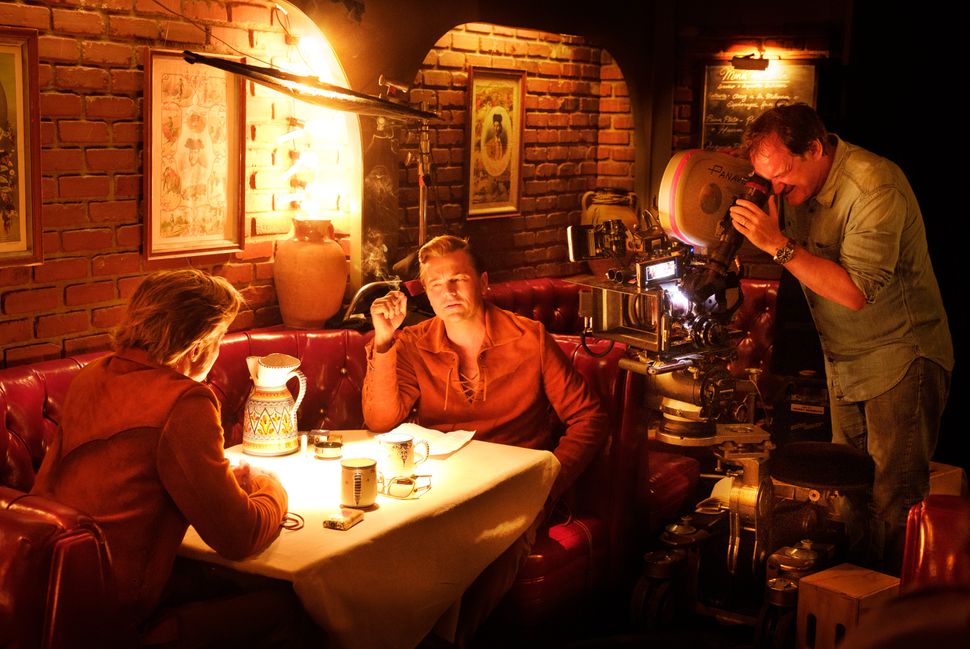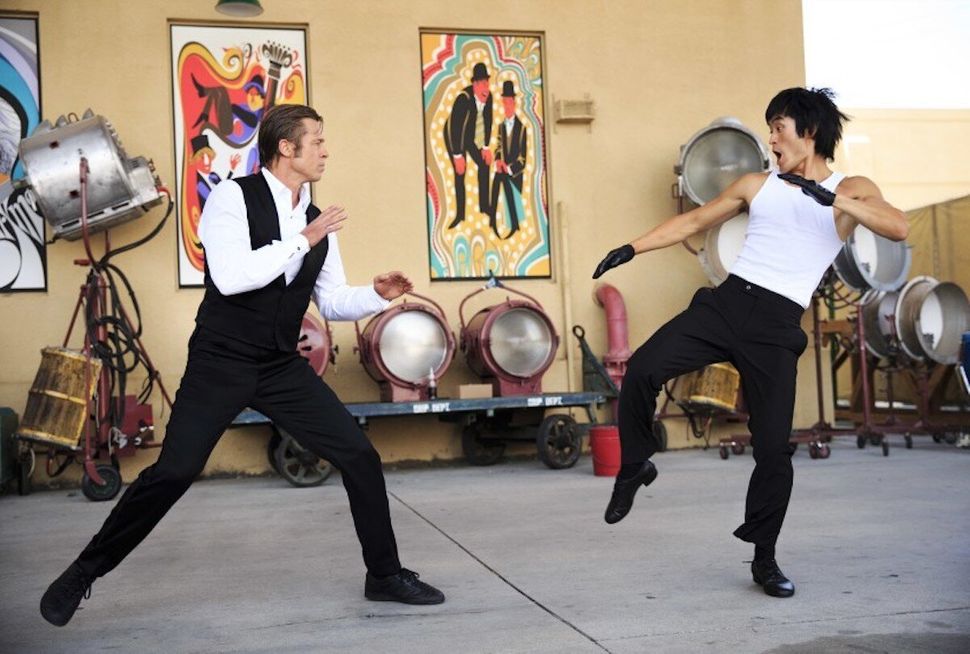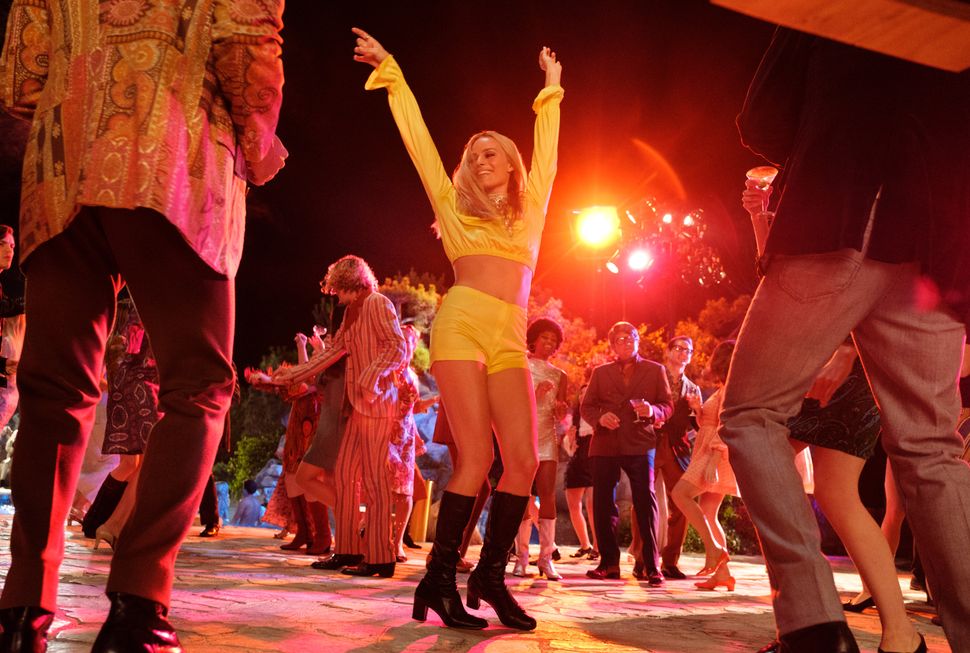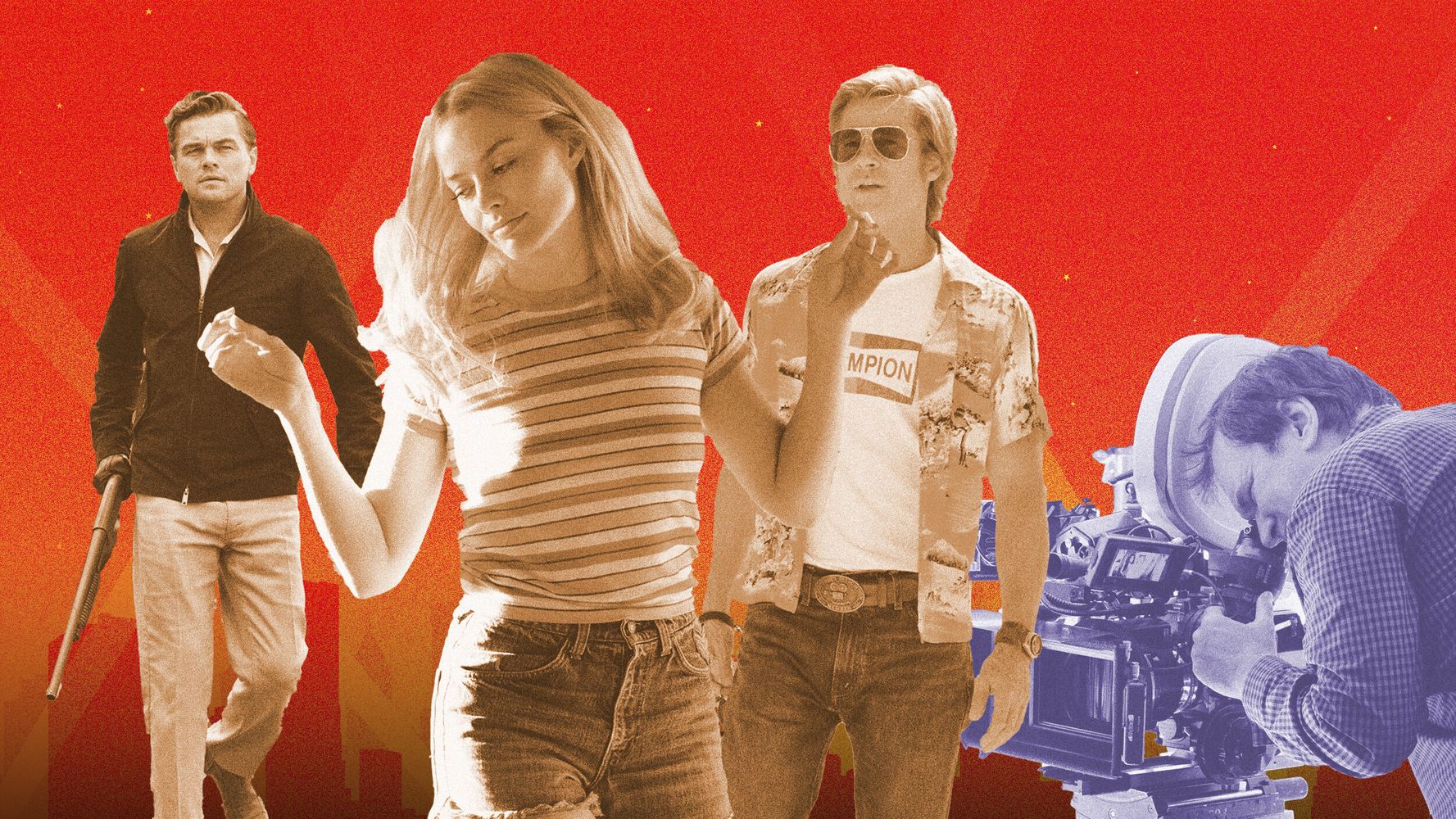[ad_1]
“Once Upon a Time in Hollywood” is Quentin Tarantino’s salute to what he loves most: movies. On Los Angeles backlots and inside lavish homes where the rich and famous dwell, egos may rule, but everyone shares an unyielding desire to create something magical. Do it well enough, and they’ll be mythologized in the American consciousness forever — or at least until somebody else comes along and waves a shinier wand. More than any of Tarantino’s previous work, the film has a sweet core. Behind the wealth and scandals that haunt Tinseltown are real people, from the uptight headliners and their fearless stunt doubles to the era-defining directors and their obsessive hangers-on, each just as complicated as the rest of us.
Making “Once Upon a Time in Hollywood” also required a lot of real people, toiling for months to put together Tarantino’s sterling romp about fading star Rick Dalton (Leonardo DiCaprio) and his exceedingly loyal stuntman and gofer Cliff Booth (Brad Pitt). Set amid the changing tides of 1969, the film explores the moment at which Rick’s fame — built on gun-toting Westerns that are now passé — is being eclipsed by the decade’s countercultural wave. Rick’s neighbor Roman Polanski (Rafal Zawierucha) is a figurehead for a new type of movie magic that favors psychological nuance and stylistic complexity. That puts Rick in close quarters with Polanski’s wife, the burgeoning actress Sharon Tate (Margot Robbie), who that year was slaughtered by members of Charles Manson’s cult.
Clocking in at almost three hours, “Once Upon a Time” is a feast for pop-culture lovers and revisionist-history diehards alike. Because this is a Tarantino flick we’re talking about, it’s rife with tiny details and sight gags that give the story zeal. Especially compared to his last project, “The Hateful Eight,” which was talky and cynical, the film is a reflective, optimistic valentine that begs for repeat viewings.
It also begs for behind-the-scenes anecdotes. So I talked to a handful of people — the stunt coordinator, the cinematographer, a few actors, the prop master and the production designer — to find out what they could tell me about Tarantino’s latest masterstroke. Here are seven tales, dispatched from once upon a not-so-distant time in Hollywood.
Tarantino’s Secretive Script Reads
Tarantino has been burned too many times to take any risks in disseminating his screenplays. The scripts for his last three movies — “Inglourious Basterds,” “Django Unchained” and “The Hateful Eight” — all leaked online before production had finished. This time around, he shrouded everything in secrecy. Only one copy of the full script existed, and it was locked in a safe at Tarantino’s office. Those who were allowed to read it had to go there or to his house to do so, and each signed a nondisclosure agreement. Most people working on the movie were only privy to certain portions of the script, and very few knew what the climactic ending entailed.
Barbara Ling, the production designer, read the “novelesque” text at Tarantino’s Los Angeles home, where an assistant brought it to her in a private room. “This script was the best script I ever even imagined you could read,” she said. Lorenza Izzo, who plays the actress Rick Dalton marries after a six-month stint making low-grade Italian Westerns, had to go to the set and read the script in a trailer, after which she promptly gave it back. Kate Berlant, the comedian who plays a box-office clerk, was only exposed to her one scene and had little information about the overall plot.
For Robert Richardson, Tarantino’s longtime cinematographer, the stakes were even higher. “I went to his house to have dinner,” Richardson explained. “We had drinks beforehand. We were talking about the movie and how to possibly shoot it. Then I sat down in the kitchen, which is adjoining the little dining-room table that adjoins his living room. I was thinking he was going to leave. He didn’t. He was walking about the living room the entire read. And I’m talking three and a half hours. And I’m writing notes down. I could see him in the corner, and he’d just sort of look and see if there’s a smile on my face and why I was making a note. He would calculate how deep I was into the script, how many pages. It was very difficult and hard to do. But I have such a close relationship with him. For me, I didn’t mind. I didn’t have anything to hide.”
At that point, Richardson said, Tarantino was meeting with DiCaprio, Pitt and Tom Cruise to decide which combination of the two he’d cast in the lead roles. As far as Richardson knew, Cruise could have played either of the parts that eventually went to DiCaprio and Pitt. But casting aside, there was one glaring holdup.
“When I finally left, I said, ‘Oh, the only thing I’m missing is the ending,’” Richardson recalled. “He gave us no ending.”
Only DiCaprio, Pitt and Robbie knew the revisionist finale before the five-month production began. Two months ahead of shooting the culminating sequence, Richardson and others were finally given the film’s conclusion at Tarantino’s office.
And that wasn’t the only precaution taken to avoid leaks. “There was a big rule on set of no cellphones, and I loved it,” Izzo said. “I can’t tell you the amount of times you’re on set and everyone starts looking at their phone. On the set, we had a point where you would check in your phones, like valet.”
In the end, the project avoided any spoilers trickling out prior to the release. That mystique helped it to feel like an event, which perhaps contributed to a bigger-than-expected haul during its first weekend in theaters.
Maybe that’s what was in the gleaming, hyper-covert “Pulp Fiction” briefcase all along: the “Once Upon a Time in Hollywood” screenplay.

A Tale Of Two Pit(t)s
“Once Upon a Time in Hollywood” is a twofold buddy comedy. The rich relationship between Rick and Cliff undergirds the story, but when Cliff isn’t tending to his oft-drunken pal’s many needs, he has another heavyweight in his life: Brandy, a brown pit bull.
The film’s posters cite a dog named Sayuri as the canine thespian that played Brandy, but the role actually required three different pit bulls of varying temperaments: two females and a more aggressive male for the violent ending. “I don’t want to ruin it for anybody, but if you want to take a close look, you might find out that Brandy is Brandon,” Richardson said.
Brandy is a good girl, but Cliff has trained her to attack on command. Enacting those scenes without anyone getting hurt was tricky. “The viciousness that we wanted would determine which dog we would use,” stunt coordinator Robert Alonzo said. “What we really had to explain to everyone was that the dogs had to feel like they were having fun. It has to feel like a constant game. … As with most people who have dogs, it’s not only necessarily training the dog, but it’s also training the owner.”
That means Pitt needed to bond with the entire trio so his chemistry with them would feel as convincing as his chemistry with DiCaprio. Picture it: Pitt — shirtless or not; your pick — and a pit bull nuzzling up to each other in ecstasy. Handlers would bring the pooches to the set early so Pitt had time with them before the cameras rolled. “He would always go up to them and feed them or touch them so he could keep that bond going knowing that the scene was about to play,” Richardson said.
The Dog Food Was Tarantino’s Invention
Tarantino is known for concocting fictitious brands, a device that helps to connect his movies. Big Kahuna Burger appears in “Reservoir Dogs,” “Pulp Fiction” and Tarantino’s segment of the anthology film “Four Rooms.” The Japanese airline Air O is seen in “Kill Bill” and “Death Proof.” Most famously, Red Apples cigarettes ― first introduced in “Pulp Fiction” ― pop up in almost all of his catalog, including the closing credits of “Once Upon a Time in Hollywood.”
Now we can add Wolf’s Tooth to the list. At a mobile home where Cliff lives behind the historic Van Nuys Drive-In theater, he has a cabinet filled with vintage-seeming Wolf’s Tooth cans. The slogan: “Good Food for Mean Dogs.” The mouth-watering flavor options: raccoon, bird, rat, lizard.
But even fake dog food requires a little science. Tarantino wanted the cylinder of congealed chow to slide out and land in Brandy’s bowl in one perfect, if slightly gross-looking, clump; he even wrote it into the script. Chris Call, the prop master, had to “audition” dog foods to see which real brand had the best slide and could therefore serve as a Wolf’s Tooth substitute. He tested four brands, ultimately landing on Pedigree.

The Bruce Lee Scene Almost Ended Differently
One of the most memorable scenes in “Once Upon a Time in Hollywood” finds Cliff squaring off with the legendary Bruce Lee (Mike Moh) on the set of the short-lived TV series “The Green Hornet,” which in this universe also featured Rick. The moment reveals Cliff’s formidability. If he can hold his own against history’s most famous martial-arts star, who knows what Cliff is capable of? (Murder, perhaps.)
When Bruce brags about being able to beat Mohammed Ali in a fight ― “My hands are registered as lethal weapons,” he purrs ― Cliff chuckles, in turn angering Bruce, who challenges him to an immediate standoff in front of the crew. Whoever lands on his butt after three rounds loses. But after Cliff takes a punch, he hurls Bruce into a parked car, at which point the stunt coordinators (Kurt Russell and Zoë Bell) put a swift end to the affair and kick Cliff off the set. That leaves the contest unfinished.
In the initial script, however, no one interrupted the fight. Cliff emerged a more clear-cut winner, which made Bruce the loser. That didn’t sit well with Alonzo or Pitt, who were keenly aware of Lee’s cultural renown.
“I know that Brad had expressed his concerns, and we all had concerns about Bruce losing,” Alonzo recalled. “Especially for me, as someone who has looked up to Bruce Lee as an icon, not only in the martial-arts realm, but in the way he approached philosophy and life, to see your idol be beaten is very disheartening. It really pulled at certain emotional strings that can incite a little anger and frustration as to how he’s portrayed. … There’s a certain mythology and mysticism about who Bruce Lee is, which is understandable. Being an Asian American myself, I definitely related to how Bruce was a symbol of how Asians should be portrayed in movies, instead of the old ‘Breakfast at Tiffany’s’ model that was really prevalent back in the day. … I had a difficult time choreographing a fight where he lost. Everyone involved was like, ‘How is this going to go over?’ Brad was very much against it. He was like, ‘It’s Bruce Lee, man!’”
Round 3 of the fight would have been a much longer battle in which both men kept going at each other, with Cliff eventually making what Alonzo called a “cheap-shot move” that put Bruce on his butt. But the point wasn’t to turn Bruce into the underdog, Alonzo told Tarantino. Rather, it was simply to “explain to the audience the level at which Cliff was [operating].” So Tarantino agreed to have the “Green Hornet” stunt coordinators break up the brawl before the third round, meaning no proper victor could be declared.
As for the actual fight, Alonzo spent nearly three months, on and off, training Pitt and Moh in various modes of hand combat. Then they spent more time rehearsing the specific choreography needed to make the scene look natural. At no point could the men display what Alonzo calls a “concentration face” — the phony look that actors sometimes evince when they are performing contrived stunts. “I’ve done so many movies with Tom Cruise that I know how to get people to do their own stunts,” he said. Everything we see is actually Pitt and Moh, including the uproarious car slam.
Locals Weren’t Pleased To See Spahn Ranch Return
Deep into “Once Upon a Time in Hollywood,” as Charles Manson’s followers play an increasing role in the events, an eeriness sets in. Cliff picks up a hitchhiker (Margaret Qualley) who requests a ride to Spahn Ranch, the 55-acre land that once housed Western movie sets and a horseback-riding operation. In 1968, the so-called Manson Family moved to Spahn Ranch, convincing the eponymous owner (played by Bruce Dern) to let them reside there rent-free in exchange for labor. The site ― fairly dilapidated by the time Manson and his mostly female disciples took over ― came to represent the counterculture’s evil underbelly. What used to be a productive, joyful place became a haven for racist murderers.
It makes sense, then, that some nearby residents were aggrieved when they saw Spahn Ranch being rebuilt at a public park near the Santa Susana Mountains, where it was originally located. “They thought it was going to be a movie about the Manson Family,” Ling said. “There was pushback to the [Los Angeles Department of Recreation and Parks], and the park came back and said, ‘Stop. This is just one set of a Tarantino movie.’”

At First, Leo Wasn’t So Sure About The Flamethrower
DiCaprio had to work with one of the most intimidating props in cinema history: a flamethrower, the self-explanatory weapon that was common during both world wars. A quick flashback to an “Inglourious Basterds”-esque movie scene featuring Rick torching a cabal of Nazis required DiCaprio to actually set his co-stars on fire ― a task that would make any sensible person nervous, even one whose targets are covered in flame-retardant material.
Alonzo, who after 23 years in the business has “a lot of experience with fire-burning,” demonstrated the Nazi scene for DiCaprio by allowing himself to be set ablaze first. “Leo was not very gung-ho with all the flamethrower stuff,” Alonzo said. “Literally, he doesn’t want to hurt anyone. And I completely understood it. Normally you use a stunt person in that spot to be able to manage firing a flamethrower at somebody. When I did ‘Tropic Thunder,’ Nick Nolte [accidentally] fired a flamethrower at me. … This time, [Leo] is actually lighting them up and holding a flame to them for about seven to eight seconds as the flamethrower is traversing back and forth around eight guys that he’s never met. That is psychologically difficult to do, so kudos to him on being able to stay in character and do that scene.”
It “took some coaxing” to make DiCaprio comfortable. When he saw that everyone in Alonzo’s demonstration was indeed safe, DiCaprio made everyone in the room give him a round of applause.
DiCaprio’s Eye-Contact Rumors Are Apparently False
In a story about DiCaprio’s career, The Hollywood Reporter cited an anonymous “on-set source” who claimed that some crew members were told to avoid eye contact with the A-list actor. Richardson and Ling both quashed the rumor.
“He’s the sweetest,” Ling said, insisting no such command was issued.
Richardson said most movie stars aren’t the divas we like to think they are, a theory that “Once Upon a Time in Hollywood” echoes in its humanizing depiction of Rick’s career dip. Closing yourself off from the crew, Richardson said, is the “wrong energy” for a medium that requires constant collaboration among hundreds of people.
“They said the same thing about Ben Kingsley, that you couldn’t look him in the eye,” said Richardson, who shot Kingsley in “Hugo” and praised his professionalism.
“And Val Kilmer,” Ling continued. Both worked with him on “The Doors,” the 1991 biopic about the titular rock band. “Not true.”
REAL LIFE. REAL NEWS. REAL VOICES.
Help us tell more of the stories that matter from voices that too often remain unheard.
[ad_2]
Source link

